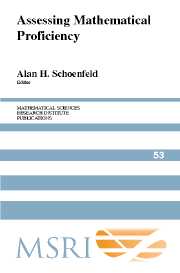Book contents
- Frontmatter
- Contents
- Preface
- Acknowledgments
- Section 1 The Big Picture
- Section 2 Perspectives on Mathematical Proficiency
- Section 3 What Does Assessment Assess? Issues and Examples
- Section 4 The Case of Algebra
- Section 5 What Do Assessments Assess? The Case of Fractions
- Section 6 The Importance of Societal Context
- 17 Assessment in France
- 18 Assessment to Improve Learning in Mathematics: The BEAR Assessment System
- 19 English Learners and Mathematics Learning: Language Issues to Consider
- 20 Beyond Words to Mathematical Content: Assessing English Learners in the Mathematics Classroom
- 21 Assessment in the Real World: The Case of New York City
- 22 Perspectives on State Assessments in California: What You Release Is What Teachers Get
- Epilogue: What Do We Need to Know? Items for a Research Agenda
- About the Authors
- Subject Index
- Author Index
- Task Index
20 - Beyond Words to Mathematical Content: Assessing English Learners in the Mathematics Classroom
Published online by Cambridge University Press: 06 July 2010
- Frontmatter
- Contents
- Preface
- Acknowledgments
- Section 1 The Big Picture
- Section 2 Perspectives on Mathematical Proficiency
- Section 3 What Does Assessment Assess? Issues and Examples
- Section 4 The Case of Algebra
- Section 5 What Do Assessments Assess? The Case of Fractions
- Section 6 The Importance of Societal Context
- 17 Assessment in France
- 18 Assessment to Improve Learning in Mathematics: The BEAR Assessment System
- 19 English Learners and Mathematics Learning: Language Issues to Consider
- 20 Beyond Words to Mathematical Content: Assessing English Learners in the Mathematics Classroom
- 21 Assessment in the Real World: The Case of New York City
- 22 Perspectives on State Assessments in California: What You Release Is What Teachers Get
- Epilogue: What Do We Need to Know? Items for a Research Agenda
- About the Authors
- Subject Index
- Author Index
- Task Index
Summary
Introduction
In the U.S., approximately 4.5 million (9.3%) students enrolled in K–12 public schools are labeled English learners [NCES 2002]. In California, during the 2000–2001 school year 1.5 million (25%) K–12 public school students were labeled as having limited English language skills [Tafoya 2002]. For numerous reasons, the instructional needs of this large population warrant serious consideration.
Assessment is particularly important for English learners because there is a history of inadequate assessment of this student population. LaCelle-Peterson and Rivera [1994] write that English learners “historically have suffered from disproportionate assignment to lower curriculum tracks on the basis of inappropriate assessment and as a result, from over referral to special education [Cummins 1984; Durán 1989; Ortiz and Wilkinson 1990; Wilkinson and Ortiz 1986].”
Previous work in assessment has described practices that can improve the accuracy of assessment for this population [LaCelle-Peterson and Rivera 1994]. Assessment activities should match the language of assessment with language of instruction and “include measures of content knowledge assessed through the medium of the language or languages in which the material was taught.” Assessments should be flexible in terms of modes (oral and written) and length of time for completing tasks. Assessments should track content learning through oral reports and other presentations rather than relying only on written or onetime assessments. When students are learning a second language, they are able to display content knowledge more easily by showing and telling, rather than through reading text or choosing from verbal options on a multiple-choice test.
- Type
- Chapter
- Information
- Assessing Mathematical Proficiency , pp. 345 - 352Publisher: Cambridge University PressPrint publication year: 2007
- 17
- Cited by



